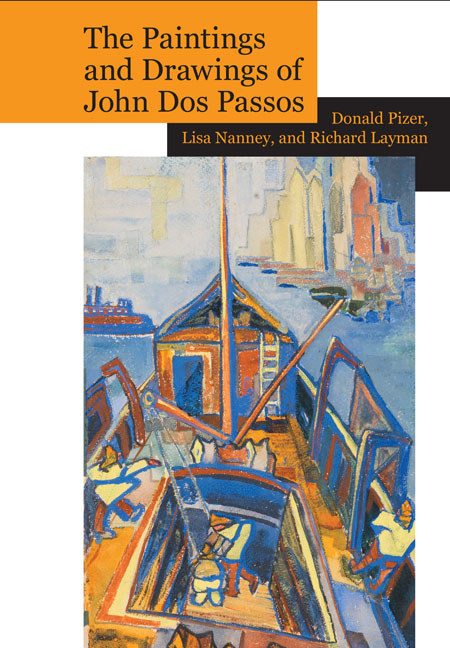Book contents
- Frontmatter
- Contents
- Preface
- Acknowledgments
- The Paintings and Drawings of John Dos Passos: A Collection and Study
- Introduction
- Paintings and Drawings Included in this Volume: A Descriptive List
- Preface to Section 1: Early Work 1918–20
- Preface to Section 2: The Middle East and Morocco 1921–22, 1926
- Preface to Section 3: Paris 1921–25
- Preface to Section 4: New York 1920–24
- Preface to Section 5: New York: Nudes 1920–23
- Preface to Section 6: Theater Designs 1925–28
- Preface to Section 7: Mexico 1926–32
- Preface to Section 8: Later Work 1930–70
- Preface to Section 9: Portraits
- Preface to Section 10: Sea Fronts and Harbors
- Preface to Section 11: Still Lifes
- Preface to Section 12: Studies in Motion
- Preface to Section 13: Abstractions and Other Experimental Modes
- Words and Images: The Visual Art of John Dos Passos
- The Artwork of John Dos Passos
- Notes
- Works Cited
- Index
- Plate section
Preface to Section 5: New York: Nudes 1920–23
from The Paintings and Drawings of John Dos Passos: A Collection and Study
- Frontmatter
- Contents
- Preface
- Acknowledgments
- The Paintings and Drawings of John Dos Passos: A Collection and Study
- Introduction
- Paintings and Drawings Included in this Volume: A Descriptive List
- Preface to Section 1: Early Work 1918–20
- Preface to Section 2: The Middle East and Morocco 1921–22, 1926
- Preface to Section 3: Paris 1921–25
- Preface to Section 4: New York 1920–24
- Preface to Section 5: New York: Nudes 1920–23
- Preface to Section 6: Theater Designs 1925–28
- Preface to Section 7: Mexico 1926–32
- Preface to Section 8: Later Work 1930–70
- Preface to Section 9: Portraits
- Preface to Section 10: Sea Fronts and Harbors
- Preface to Section 11: Still Lifes
- Preface to Section 12: Studies in Motion
- Preface to Section 13: Abstractions and Other Experimental Modes
- Words and Images: The Visual Art of John Dos Passos
- The Artwork of John Dos Passos
- Notes
- Works Cited
- Index
- Plate section
Summary
Although it is difficult to determine a precise dating for Dos Passos's interest in the nude as a painting subject, it can be safely said that almost all of his work of this kind stems from the early phase of his career and, even more narrowly, from the opportunity to participate in life classes. He did so sporadically in Paris in the spring of 1919, when he was a student at the Sorbonne while awaiting discharge from the Army, and more actively between May 1920 and March 1921, when he attended life classes with Adelaide Lawson at New York's Art Students League. He may also have worked in this mode on the several other occasions during the early 1920s when he was in New York for months at a time.
The Dos Passos art collection contains over a dozen nude sketches, many in charcoal or crayon that may stem from his Sorbonne period. These are of lesser interest; the bodies are awkwardly posed and drawn, with little vitality. Indeed, though many of these works depict males and females in the same sketch, there is almost no sexual energy in the portrayals. Dos Passos's New York nudes are of a very different character. In figure 26, Standing Nude, for example, the faceless model's thrusting breasts and stomach and huge forward pressing thighs constitute an image of a sexual presence, indeed, of an almost aggressive sexual belligerency. Figure 27, Seated Nude, which may be a portrait of Adelaide Lawson, is equally arresting, but now as an exercise in Expressionism in relation to the nude as subject. The skin colors of mixed yellow and light mauve, the pendulous breasts, over-extended right arm and massive bottom, and the sculptured expressionless face, all push the painting in the direction of a grotesque critique of the female form.
Dos Passos's two portraits of a dozing nude are among his most compelling works in the form. In both figures 28 (Tubular Nude 1) and 29 (Tubular Nude 2) the subject is posed similarly in a semi-crouch, head resting on one arm while hands rest on the knees. Despite an element of gigantism in the depiction of the body, figure 28 functions within a representative mode.
- Type
- Chapter
- Information
- Publisher: Liverpool University PressPrint publication year: 2016



